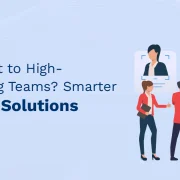Skill Gap Analysis: A skill gap analysis is a crucial process for organizations to identify the difference between the skills their workforce currently possesses and the skills needed to achieve their business goals. This analysis helps in understanding areas where training, upskilling, or new hiring is required to ensure optimal performance, innovation, and competitiveness in today’s rapidly evolving digital landscape. By pinpointing these gaps, businesses like Hurix Digital can proactively address skill deficiencies and strategically invest in talent development, ultimately leading to improved productivity and a more skilled and adaptable workforce.
What is Skill Gap Analysis?
Skill gap analysis is a critical process for organizations to identify the difference between the skills their workforce currently possesses and the skills needed to achieve future business objectives. It’s a strategic evaluation that pinpoints specific areas where employee skills fall short, hindering productivity, innovation, and overall business growth.
The analysis typically involves a multi-faceted approach. This can include:
- Assessment of current skills: Evaluating the existing skill sets of employees through performance reviews, skill assessments, and self-evaluations.
- Identification of required skills: Defining the skills necessary to meet future organizational goals, considering technological advancements, market trends, and strategic initiatives.
- Comparison and gap identification: Comparing the current skill inventory with the required skill set to identify specific skill gaps.
By understanding these gaps, businesses can develop targeted training programs, recruitment strategies, and talent management initiatives to bridge the divide. A well-executed skill gap analysis enables organizations to:
- Improve employee performance and productivity.
- Enhance innovation and competitiveness.
- Reduce costs associated with skill shortages.
- Boost employee engagement and retention.
- Prepare for future business challenges and opportunities.
Ultimately, skill gap analysis is a proactive approach to workforce development, ensuring that organizations have the right talent in place to thrive in a dynamic business environment.
Why is Skill Gap Analysis Important?
Skill gap analysis is crucial for organizations aiming to thrive in today’s rapidly evolving business landscape. It’s a systematic process of identifying the discrepancies between an organization’s current workforce skills and the skills needed to achieve its strategic goals. Understanding these gaps allows for targeted interventions, leading to improved performance and a competitive edge.
Firstly, skill gap analysis drives strategic decision-making. By pinpointing specific skill deficiencies, businesses can make informed decisions about training investments, recruitment strategies, and talent development programs. This ensures resources are allocated efficiently to address the most pressing needs.
Secondly, it enhances employee performance and engagement. Identifying areas where employees need additional support allows for personalized training and development opportunities. This fosters a culture of continuous learning, boosting employee morale, productivity, and retention. Employees who feel supported in their growth are more likely to be engaged and contribute effectively.
Thirdly, skill gap analysis future-proofs the organization. By anticipating future skill needs based on industry trends and technological advancements, businesses can proactively prepare their workforce. This proactive approach ensures the organization remains agile and adaptable, ready to embrace new challenges and opportunities.
In conclusion, skill gap analysis is not just a reactive measure; it’s a proactive investment in an organization’s future. It empowers businesses to build a skilled, engaged, and future-ready workforce, ultimately driving innovation, growth, and sustained success.
How Does Skill Gap Analysis Work?
Skill gap analysis is a structured process used to identify the difference between the skills an organization currently possesses versus the skills it needs to achieve its strategic goals. It’s a crucial element in workforce planning and talent development.
The process typically involves these key steps:
- Defining Required Skills: First, clearly define the skills, knowledge, and abilities (SKAs) necessary for current and future roles. This should align with the company’s overall business strategy and consider emerging technologies or industry trends. Job descriptions, performance reviews, and future project requirements all contribute to this definition.
- Assessing Existing Skills: Next, evaluate the current skill levels of employees. This can be done through various methods, including performance appraisals, skills assessments (tests, simulations), self-assessments, 360-degree feedback, and interviews. The goal is to get an accurate picture of what employees can currently do.
- Identifying the Gaps: Compare the required skills with the existing skills. The difference between the two reveals the skill gaps. These gaps can be at an individual, team, or organizational level. Prioritize the gaps based on their impact on business objectives.
- Developing Action Plans: Once the gaps are identified, create targeted development plans to close them. This might include training programs, mentoring, upskilling initiatives, reskilling efforts, new hires, or outsourcing specific tasks.
- Monitoring and Evaluation: Regularly monitor the progress of the action plans and evaluate their effectiveness. Are the skill gaps closing? Are the initiatives delivering the desired results? Adjust the plans as needed to ensure continuous improvement and alignment with evolving business needs.
By systematically analyzing skill gaps, organizations can proactively address talent shortages, improve employee performance, and ensure they have the right skills in place to achieve their strategic objectives.
Examples of Skill Gap Analysis in Action by Leading Brands
Skill gap analysis isn’t just theory; leading brands across industries actively leverage it to stay competitive and innovative. Here are a few compelling examples:
Amazon: Faced with the rapid evolution of cloud computing and AI, Amazon utilizes skill gap analysis to identify the skills needed to support its AWS services and broader technological advancements. They then proactively invest in internal training programs and external recruitment efforts to bridge these gaps, ensuring a workforce capable of handling complex cloud infrastructure and AI development.
Accenture: As a global consulting firm, Accenture recognizes the critical importance of its employees possessing cutting-edge skills. They conduct regular skill gap analyses to assess the difference between their current workforce capabilities and the evolving demands of their clients and the market. This informs their robust learning and development initiatives, enabling their consultants to deliver impactful solutions in areas like digital transformation and cybersecurity.
General Electric (GE): In its manufacturing and industrial sectors, GE uses skill gap analysis to identify areas where employee skills need to be upgraded to support new technologies and processes, such as additive manufacturing (3D printing) and advanced robotics. This enables them to improve efficiency, reduce costs, and maintain their competitive edge in a rapidly changing industrial landscape. Their focus includes both technical and soft skills development programs.
Unilever: With a diverse portfolio of consumer goods brands, Unilever uses skill gap analysis to ensure its workforce has the capabilities to meet the evolving needs of its consumers. This includes identifying skills gaps in areas like data analytics, e-commerce, and digital marketing. By bridging these gaps, Unilever can better understand consumer behavior, optimize its online presence, and develop more effective marketing campaigns.
These examples showcase how leading brands across diverse sectors strategically use skill gap analysis to proactively address their evolving workforce needs, stay ahead of the competition, and drive innovation.
Key Benefits of Skill Gap Analysis
Skill gap analysis offers numerous strategic advantages for organizations aiming to thrive in today’s rapidly evolving landscape. By systematically identifying discrepancies between existing employee skills and those required to achieve business objectives, companies can unlock significant potential.
One key benefit is improved organizational performance. By pinpointing skill deficits, businesses can proactively address weaknesses that hinder productivity and innovation. Targeted training and development programs can then be implemented to upskill employees, leading to enhanced efficiency and higher quality outputs.
Furthermore, skill gap analysis facilitates strategic workforce planning. It provides valuable insights into future skill needs, enabling HR departments to anticipate talent requirements and make informed decisions regarding recruitment, training, and succession planning. This ensures the organization has the right skills in place to meet future challenges and opportunities.
Another critical advantage is increased employee engagement and retention. When employees are given opportunities to develop their skills and close identified gaps, they feel valued and invested in. This fosters a culture of continuous learning and improvement, boosting morale and reducing employee turnover. Investing in employee development demonstrates a commitment to their growth, making them more likely to stay with the company.
Finally, skill gap analysis supports enhanced innovation and competitiveness. By ensuring employees possess the skills necessary to leverage new technologies and adapt to changing market demands, companies can foster a culture of innovation and gain a competitive edge. Staying ahead of the curve requires a workforce equipped with the latest knowledge and skills, and skill gap analysis provides the roadmap to achieve this.
Common Misconceptions Around Skill Gap Analysis
Skill gap analysis is a powerful tool, but several misconceptions can hinder its effective implementation and lead to inaccurate results. Understanding these common pitfalls is crucial for maximizing the value of this process.
Misconception 1: It’s a One-Time Event: Many believe a skill gap analysis is a project to be completed once and then forgotten. In reality, the business environment evolves rapidly, requiring continuous assessment to identify emerging skill needs and maintain a competitive edge. Regular, iterative analyses are essential.
Misconception 2: It’s Solely About Identifying Deficiencies: While identifying areas where employees lack skills is important, a comprehensive skill gap analysis also uncovers existing strengths and potential areas for growth. It should highlight both the gaps and the assets within the workforce.
Misconception 3: Generic Training Programs Are the Solution: Thinking that a single, generic training program can address all identified skill gaps is a mistake. Effective solutions require targeted interventions tailored to specific roles, skill deficiencies, and individual learning styles. Personalized learning paths are often more effective.
Misconception 4: It Ignores Employee Aspirations: A skill gap analysis shouldn’t solely focus on current and future business needs. Ignoring employee career goals and aspirations can lead to disengagement and high turnover. Aligning skill development with individual ambitions creates a more motivated and skilled workforce.
Misconception 5: It’s the Responsibility of HR Alone: While HR plays a vital role, skill gap analysis is a collaborative effort. Input from department heads, team leaders, and individual employees is critical for gaining a holistic understanding of skill needs and developing effective solutions. A cross-functional approach is key to success.




